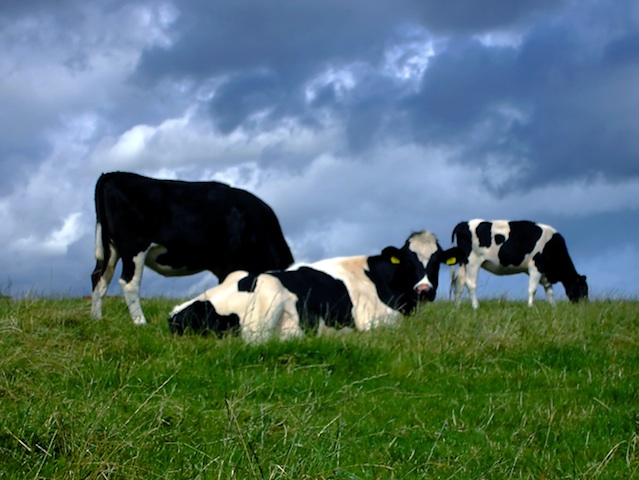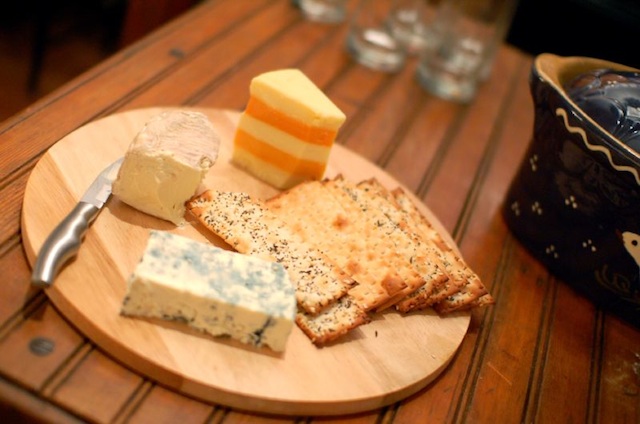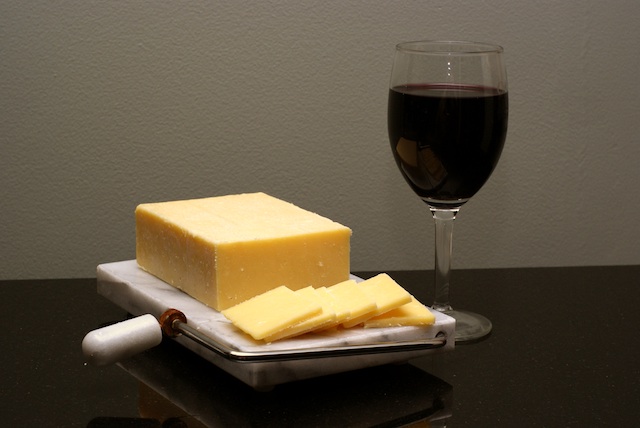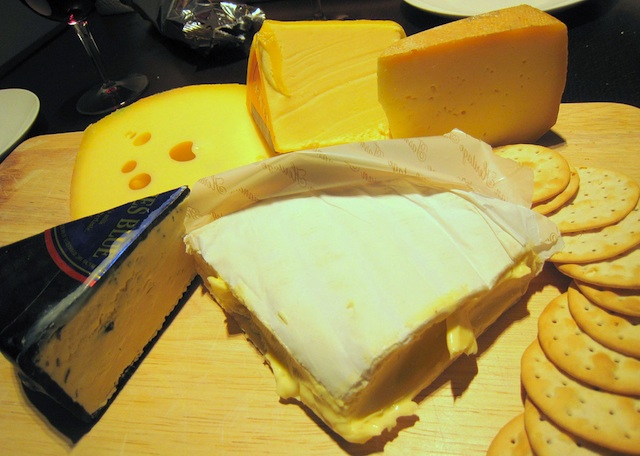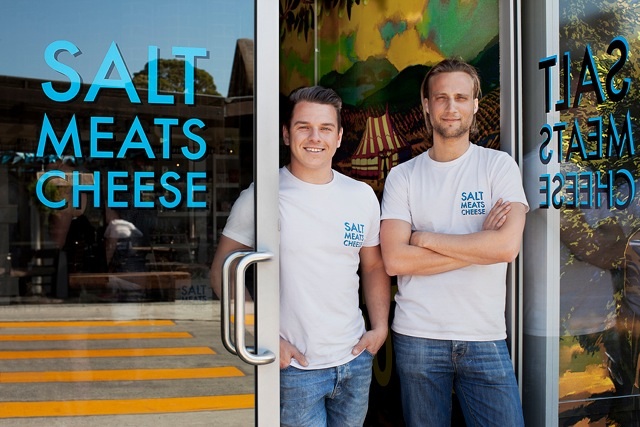A Bluffer’s Guide to Cheese
If you're sick of bringing the crackers and drip to the party listen up. Here's Concrete Playground's Bluffer's Guide to Cheese.
If you're sick of bringing crackers and dip to the party, but get cheese blind when faced with a fridge full of fromage, then read on. There's no need to taste everything in the deli (although that isn't ever a bad idea), and we've a little something for you to ensure cheese no longer becomes such a pandemonium requiring social etiquette. Soon you'll be able to tell everyone how nutty but sweet the prima donna is.The Dutch-style gouda, that is.
So, fromage fans, listen up: here's Concrete Playground's bluffer's guide to cheese.
1. Cheese 101: How is Cheese made?
Apparently, the process of cheese making was an accident. The story goes that milk overheated in a storage container of some sort, soured and created curd. Now don't squirm, but rumour has it that the said 'container' was either an animal's internal organ or an inflated animal skin.
Nowadays, it's more of a civilised process. The milk (from a cow, sheep, goat or buffalo) is pasteurised (heated then cooled to remove harmful pathogens) then starter cultures and rennet are added. This causes the milk to coagulate into an attractive custard-like mess. Miss Muffet then separates the curds and whey (milk serum) and appropriately ripens to enhance the variety of textures and flavours.
2. Varieties
Stefano De Blasi of Salt Meats Cheese providores in Alexandria, advises that varieties of cheese are distinguished according to a range of criteria. "The age, texture, fat content, country of origin and animal milk all makes a difference," he says.
So how can one identify all those cheeses at the deli? It is possible to judge a cheese's character by its rind; the texture, taste, strength of flavour, and even maturity. However, for us cheese novices, it's best to just remember these types to get the mozzarella ball rolling.
- Fresh cheese: feta, cottage, ricotta and cream cheese
- Soft white cheese: brie and camembert
- Washed rind (warning: stinky): tallegio and langres
- Blue: roquefort, gorgonzola, stilton
- Semi-hard: cheddar, manchego and gruyere; and
- Hard (robust flavour): parmesan.
And lest we remind you that there's always the 'try before you buy' option.
3. Storing cheese
The common rule of storing cheese is to store in its original wrapping. Failing that, plastic wrap is fine. If left unwrapped, the cheese will dry out and lose flavour. Harder cheeses have a longer shelf life than fresher types, such as a cream cheese or feta. These should be kept in their container with the lid on so no air can get in. If you start to smell something funkier than the cheese should, toss it.
Make sure blue cheese and rind cheeses are kept tightly wrapped and separate to other food as their odour is quite strong. Again, you don't want your housemates to think something died in the fridge every time they open it up to get their milk.
Mozzarella and bocconcini should be kept in their water, and don't get turned off if the water starts to get mirky coloured. It's just the milk in the water as the cheese releases its salt. But, as Stefano says, "to be honest, I never store. I always open and finish what I eat!" So shame on you if there are leftovers.
4. The perfect cheese board
When preparing a cheese board, Stefano suggests not having more than three cheeses on offer and only one or two accompaniments per cheese. It's also best to bring the cheeses to room temperature in order to appreciate their full flavour. As a guide, you generally want a soft white cheese (such as brie), a blue (Ra Roquefort from France) and a firmer type (such as vintage cheddar). But don’t be afraid to ask your cheesemonger for recommendations.
Encourage guests to cut wedges 'nose to tail' and cheese with rinds from centre to the edge. And don't forget to allow a few knives for cutting. You can't have the Stinking Bishop on the Jean de Brie. In terms of accompaniments, "definitely sliced pear, fig jam, quince paste or even orange marmalade, muscatel grapes and honey. And olives of course!" says Stefano.
5. Matching cheese with wine
Cheese and wine. They're a perfect match. Complimenting the two requires a bit of time and experiment, but lest we forget to remind you that one without the other is a social faux pas. You can't go too wrong, however, if you follow the golden rule: the whiter and fresher the cheese, the whiter and crisper the wine; the darker and stronger the wine, the darker and stronger the cheese.
For instance, brie is best matched with a dry sparkling or chardonnay; edam is great with a shiraz, grenache or pinot noir; and camembert's delicate 'mushroomy' character would be nicely offset with a sparkling white. Stefano highly recommends manchego for a dry white, and a simple cheddar for any red. He also emphasises that "any cheese will be good!" Cheese to that, we say.
6. Best melting cheese for pizza
Mozzarella is originally from Italy, so it goes without saying that it would be the most ideal cheese for a pizza. "I love the buffalo mozzarella, just because of its white colour", says Stefano, "my pizza is just red and white. The tomato and the mozzarella." Bocconcini (any type is good) goes down a treat on pizzas too; its semi-soft elastic texture is mild, yet a little sweet. Stefano recommends cherry bocconcini. "The small balls are easy to slice and melt beautifully," he says.
7. European vs Australian ... similarities and differences
With over 45 countries producing their own varieties of different cheeses, how on earth are we meant to decipher the difference ourselves? Basically, the flavour is affected by its origin. So essentially this comes down to what grass the cows or sheep are grazing on. For example, all blue cheeses are named so because of the mould Penicillin that is added, however, each has their own flavour and characteristic.
A Bleu de Gex from Germany may be richer than a gorgonzola from Italy. The Greek's tend to add more salt to their varieties too. Think haloumi and feta (compared to a creamier Danish type). Most cheeses are named so after their place of origin. Fine examples include Gruyere, (Switzerland), Brie (region in France), Cheddar (England), Fontina (Italy), Havarti (named after a Danish farm called Havarthigaard) and Jarlsberg (Norway).
8. Cheese on a budget
This can be done. Visit your local deli and suss out what's on special. Don't be shy to ask for a taste too. if you're going to be spending your pennies on cheese, it has to please. Stefano says that camembert, manchego, local vintage and smoked cheddar are generally going to be the more affordable varieties and "will always go down a treat no matter what".
Pricier cheeses don't necessarily indicate that they will knock your socks off either, as it is a matter of preference. The price is just an indication that it's from a smaller farm and/or imported. Artisan cheeses are often more expensive as they are made by hand using traditional methods.
9. Talk like a pro
Before you go forth and preach the gospel of cheese to your friends, brush up on these decorative phrases to raise a few brows ...
- "Wow, the camembert has a very pronounced, 'mushroomy' flavour."
- "This pecorino grated on the pasta is quite piquant and not too acidic. It’s not as strong as Parmesan Reggiano and seems to add a strong dimension to the dish."
- "I like semi-soft cheeses such as Monterey Jack, for its mild and buttery flavour. It goes perfectly with a good lager."
- "Epoisses is quite voluptuous with a well-rounded flavour."
- "I'm after something a little nutty, yet mild and pleasant. Nothing too earthy and pungent please."
10. Sydney's best cheese stores
Salt Meats Cheese
This wholesale warehouse is open to the public and packed full of gourmet items that are imported from top suppliers around the world. There is an entire cold room dedicated to cheese and a mozzarella lab where you can watch them (and soon learn) make the goods. 41 Bourke Street, Alexandria; 02 9690 2406.
Formaggi Ocello
Specialising in Italian cheese, they also hold cheese and wine pairing nights and also sell a wide selection of olives, antipastos and cold meats. Shop 16/425 Bourke Street, Surry Hills; 02 9357 7878.
Gourmet Grocer Balmain
A food lover's emporium stocking cheese and charcuterie delicacies. Many a cheese award under the belt. 332 Darling Street, Balmain; 02 9818 3354.
Blackwattle Deli
With a huge amount of cheese on display, it can get very overwhelming, but they’re all lovely enough behind the counter to offer up good advice and tastings. Shop 8A, Bank Street, Sydney Fish Market; 02 9660 6998.
Simon Johnson Pyrmont
Cheese, homewares, recipes, you name it. Simon Johnson is a stalwart gourmet grocer here to service our every need when it comes to home entertaining. The on-site cheese room at Simon Johnson Pyrmont is definitely work checking out. 181 Harris Street Pyrmont; 02 8244 8240.
Smelly Cheese Shop
If you're out and about in the Hunter Valley, The Smelly Cheese Shop has an impressive selection of local, imported and Smelly's own cheeses, as well as gourmet deli goods. 3/188 Broke Rd, Pokolbin; 02 4998 6960.



